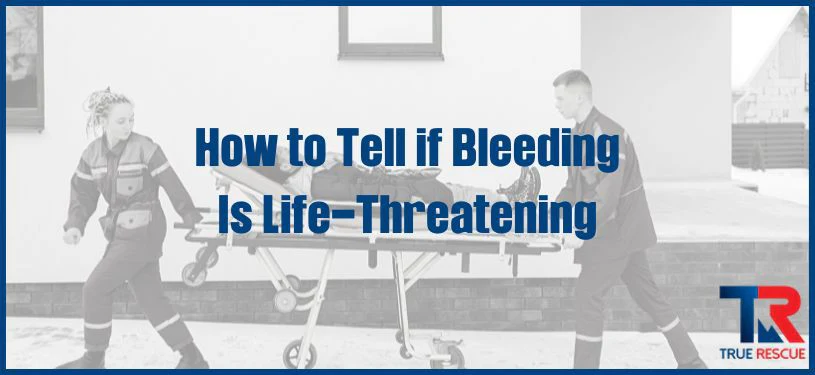Understanding Life-Threatening Bleeding: How to Identify and Respond
Introduction
Bleeding is a common occurrence in everyday life, often resulting from minor injuries such as cuts or scrapes. However, not all bleeding is harmless. Life-threatening bleeding, also known as hemorrhage, can occur due to severe injuries, medical conditions, or accidents, and it requires immediate attention. Understanding how to identify whether bleeding is life-threatening is crucial for providing timely assistance and potentially saving a life.This comprehensive article will explore the two primary ways to determine if bleeding is life-threatening, the signs and symptoms to watch for, and the appropriate first aid responses. We will also include a detailed FAQ section to address common questions related to bleeding emergencies.
What is Life-Threatening Bleeding?
Life-threatening bleeding refers to significant blood loss that can lead to serious health complications or death if not addressed promptly. It can be categorized into two types: external bleeding and internal bleeding.
External Bleeding
External bleeding occurs when blood flows out of the body through a break in the skin. This can result from cuts, abrasions, or lacerations. External bleeding can be classified as:
- Minor Bleeding: Small cuts or scrapes that can be managed with basic first aid.
- Severe Bleeding: Profuse bleeding that may require immediate medical intervention.
Internal Bleeding
Internal bleeding occurs when blood leaks from blood vessels into the body’s cavities or tissues. This type of bleeding is often less visible and can be more challenging to identify. Common causes of internal bleeding include:
- Trauma from accidents or falls
- Medical conditions such as ulcers or aneurysms
- Surgical complications
Two Ways to Determine if Bleeding is Life-Threatening
1. Assessing Blood Volume
One of the most critical indicators of life-threatening bleeding is the volume of blood lost. Understanding how much blood loss is considered significant can help you assess the situation effectively.
Blood Volume Assessment
- Adult Blood Volume: The average adult has about 5 to 6 liters of blood in their body. A loss of more than 15% (approximately 0.75 to 1 liter) can be life-threatening.
- Child Blood Volume: Children have less blood volume, approximately 70 to 80 milliliters per kilogram of body weight. For a child weighing 20 kg (44 lbs), a loss of more than 15% (around 300 to 400 ml) can be critical.
Signs of Significant Blood Loss
- Rapid Heart Rate: A heart rate above 100 beats per minute can indicate significant blood loss.
- Low Blood Pressure: A drop in blood pressure can be a sign of shock due to blood loss.
- Weakness or Dizziness: Feeling weak, dizzy, or faint can indicate that the body is not receiving enough blood flow.
2. Evaluating Blood Flow Characteristics
The characteristics of the bleeding itself can provide important clues about its severity. Here are key factors to consider:
Blood Flow Assessment
- Continuous Flow: Blood that flows steadily from a wound is more concerning than blood that oozes slowly. Continuous or spurting blood indicates a more severe injury.
- Color of the Blood: Bright red blood typically indicates arterial bleeding, which is more serious than darker, venous blood.
- Presence of Clots: If blood is clotting quickly, it may indicate that the body is attempting to stop the bleeding. However, if bleeding continues despite clotting, it may be life-threatening.
Signs of Shock
Shock is a critical condition that can result from significant blood loss. Recognizing the signs of shock is essential for determining the severity of bleeding:
- Pale, Cool, or Clammy Skin: The skin may appear pale or feel cool to the touch due to reduced blood flow.
- Altered Mental Status: Confusion, disorientation, or decreased responsiveness can indicate shock.
- Rapid Breathing: Increased respiratory rate is a common response to blood loss.
First Aid for Life-Threatening Bleeding
If you suspect that someone is experiencing life-threatening bleeding, it’s crucial to take immediate action. Here are the steps to follow:
Step 1: Call for Emergency Help
- Dial Emergency Services: Call 911 or your local emergency number immediately. Provide clear information about the situation and the location.
Step 2: Ensure Scene Safety
- Assess the Environment: Ensure that the area is safe for you to approach the injured person. Look for hazards such as traffic, fire, or unstable surfaces.
Step 3: Apply Direct Pressure
- Locate the Source of Bleeding: Identify where the bleeding is coming from.
- Use a Clean Cloth or Bandage: Apply direct pressure to the wound using a clean cloth, gauze, or your hand. Maintain pressure for at least 10 minutes without lifting the cloth to check if the bleeding has stopped.
Step 4: Elevate the Wound
- Raise the Injured Area: If possible, elevate the injured limb above the level of the heart to help reduce blood flow to the area.
Step 5: Use a Tourniquet (if necessary)
- When to Use a Tourniquet: If the bleeding is severe and does not stop with direct pressure, consider applying a tourniquet above the wound (closer to the heart).
- How to Apply a Tourniquet: Use a commercially available tourniquet or a makeshift one (like a belt or cloth). Tighten it until the bleeding stops and note the time it was applied.
Step 6: Monitor for Shock
- Check for Signs of Shock: Keep an eye on the injured person for signs of shock, such as rapid breathing, confusion, or weakness. If shock occurs, lay the person flat and elevate their legs if there are no injuries to the spine or legs.
Step 7: Stay with the Person
- Provide Reassurance: Stay with the injured person until emergency services arrive. Reassure them that help is on the way.
Table: Signs of Life-Threatening Bleeding
| Sign or Symptom | Description |
|---|---|
| Rapid Heart Rate | Heart rate above 100 beats per minute may indicate significant blood loss. |
| Low Blood Pressure | A drop in blood pressure can signal shock due to blood loss. |
| Pale, Cool Skin | Skin may appear pale or feel cool to the touch due to reduced blood flow. |
| Altered Mental Status | Confusion or decreased responsiveness can indicate shock. |
| Continuous or Spurting Blood | Blood flowing steadily or spurting from a wound indicates a severe injury. |
| Signs of Shock | Symptoms include rapid breathing, clammy skin, and weakness. |
Conclusion
Recognizing life-threatening bleeding is crucial for providing timely and effective first aid. By understanding the two primary ways to assess the severity of bleeding—evaluating blood volume and flow characteristics—you can make informed decisions about how to respond in an emergency.Taking immediate action, such as applying direct pressure and calling for emergency help, can significantly impact the outcome for the injured person. Regular training in first aid and emergency response is essential for everyone, as it equips individuals with the knowledge and skills needed to handle such critical situations.
Frequently Asked Questions
- What constitutes life-threatening bleeding?
Life-threatening bleeding is characterized by significant blood loss that can lead to shock or death if not addressed promptly. This includes continuous or spurting blood and signs of shock. - How can I tell if someone is in shock?
Signs of shock include pale, cool, or clammy skin, rapid heartbeat, rapid breathing, confusion, and weakness. - What should I do if I see someone bleeding heavily?
Call emergency services immediately, apply direct pressure to the wound, and elevate the injured area if possible. Monitor for signs of shock. - When should I use a tourniquet?
A tourniquet should be used only when bleeding is severe and does not stop with direct pressure. Apply it above the wound and note the time it was applied. - Can internal bleeding be life-threatening?
Yes, internal bleeding can be life-threatening and may not be immediately visible. Symptoms may include abdominal pain, swelling, and signs of shock.
References
“Bleeding.” MedlinePlus. https://medlineplus.gov/ency/article/000045.htm



